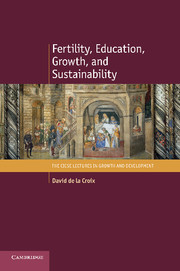Book contents
- Frontmatter
- Contents
- List of figures
- List of tables
- List of symbols
- List of definitions
- List of propositions
- Introduction
- PART ONE DIFFERENTIAL FERTILITY
- PART TWO EDUCATION POLICY
- PART THREE SUSTAINABILITY
- 7 Environmental collapse and population dynamics
- 8 Production, reproduction, and pollution caps
- 9 Population policy
- 10 Conclusion: endogenous fertility matters
- Bibliography
- Author index
7 - Environmental collapse and population dynamics
from PART THREE - SUSTAINABILITY
Published online by Cambridge University Press: 05 December 2012
- Frontmatter
- Contents
- List of figures
- List of tables
- List of symbols
- List of definitions
- List of propositions
- Introduction
- PART ONE DIFFERENTIAL FERTILITY
- PART TWO EDUCATION POLICY
- PART THREE SUSTAINABILITY
- 7 Environmental collapse and population dynamics
- 8 Production, reproduction, and pollution caps
- 9 Population policy
- 10 Conclusion: endogenous fertility matters
- Bibliography
- Author index
Summary
The sustainability of societies is questioned in a book by Diamond (2005). His main idea is that non-cooperative behavior may lead economies to collapse. If we have to translate his notion of sustainability into economic terms, we have to cast it in terms of existence of equilibrium.
Definition 7.1 Sustainability A policy is sustainable if the corresponding intertemporal equilibrium with positive population and resources exists.
Policy should be understood in a broad sense, including the type of institutions and markets which prevail. The use of “intertemporal” stresses the dynamic nature of sustainability. Let us compare our definition to the original definition of sustainability by the Brundtland Commission (1987): Development is sustainable if “[it] meets the needs of the present without compromising the ability of future generations to meet their own needs.” While this definition seems pretty clear, at least in immediate terms of intergenerational justice, it turns out to be quite hard to incorporate in the corpus of economic theory in a rigorous way.
Roughly speaking, sustainability involves two types of issues. On the one hand, sustainability insists on the importance of perpetuity, of not jeopardizing the capacity of the Earth or of humankind to go ahead with existing. On the other hand, it embodies a concern as to the intergenerational path to be followed by our societies: is our consumption such that future generations will be able to have the same level of consumption as well? Are we going to transfer them a planet in a worse state? Is growth in whichever of its forms sustainable at all?
- Type
- Chapter
- Information
- Fertility, Education, Growth, and Sustainability , pp. 153 - 183Publisher: Cambridge University PressPrint publication year: 2012

